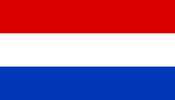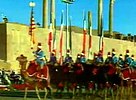Afsharid Iran
Guarded Domains of Iran | |||||||||||||||||||||
|---|---|---|---|---|---|---|---|---|---|---|---|---|---|---|---|---|---|---|---|---|---|
| 1736–1796 | |||||||||||||||||||||
 The Afsharid Empire at its greatest extent in 1741–1745 underNader Shah | |||||||||||||||||||||
| Status | Empire | ||||||||||||||||||||
| Capital | Mashhad | ||||||||||||||||||||
| Common languages | |||||||||||||||||||||
| Religion | |||||||||||||||||||||
| Government | Absolute monarchy | ||||||||||||||||||||
| Shahanshah | |||||||||||||||||||||
• 1736–1747 | Nader Shah | ||||||||||||||||||||
• 1747–1748 | Adel Shah | ||||||||||||||||||||
• 1748 | Ebrahim Afshar | ||||||||||||||||||||
• 1748–1796 | Shahrokh Shah | ||||||||||||||||||||
| History | |||||||||||||||||||||
• Established | 22 January 1736 | ||||||||||||||||||||
• Disestablished | 1796 | ||||||||||||||||||||
| Population | |||||||||||||||||||||
• Estimate | 6,000,000[5] | ||||||||||||||||||||
| Currency | Toman[6] | ||||||||||||||||||||
| ISO 3166 code | IR | ||||||||||||||||||||
| |||||||||||||||||||||
| History ofIran |
|---|
 |
|
Timeline |
TheGuarded Domains of Iran,[7][8]commonly referred to asAfsharid Iran[a]or theAfsharid Empire,[9]was an Iranian[10]empire established by theTurkoman[11][12]Afshar tribein Iran's north-eastern province ofKhorasan,establishing theAfsharid dynastythat would rule overIranduring the mid-eighteenth century. The dynasty's founder,Nader Shah,was a successful military commander who deposed the last member of theSafavid dynastyin 1736, and proclaimed himselfShah.[13]
During Nader's reign, Iran reached its greatest extent since theSasanian Empire.At its height it controlled modern-day Iran,Armenia,Georgia,Azerbaijan,Afghanistan,Bahrain,Turkmenistan,andUzbekistan,and parts ofIraq,Pakistan,Turkey,United Arab Emirates,Omanand theNorth Caucasus(Dagestan). After his death, most of his empire was divided between theZands,Durranis,Georgians,Khanate of Kalat,and theCaucasian khanates,while Afsharid rule was confined to a small local state in Khorasan. Finally, the Afsharid dynasty was overthrown byAgha Mohammad Khan Qajarin 1796, who would establish a new native Iranian empire and restore Iraniansuzeraintyover several of the aforementioned regions.
The dynasty was named after theTurkomanAfshar tribe fromKhorasanin north-east Iran, to which Nader belonged.[14]The Afshars had originally migrated fromTurkestantoAzerbaijan(Iranian Azerbaijan) in the 13th century. In the early 17th century,Abbas the Greatmoved many Afshars from Azerbaijan to Khorasan to defend the north-eastern borders of his state against theUzbeks,after which the Afshars settled in those regions. Nader belonged to the Qereqlu branch of the Afshars.[15]
History
[edit]Foundation of the dynasty
[edit]Nader Shah was born (as Nadr Qoli) into a humble semi-nomadic family from theAfshar tribeof Khorasan,[16]where he became a local warlord.[17]His path to power began when the GhilzaiMir Mahmud Hotakioverthrew the weakened and disintegratedSafavidshahSultan Husaynin 1722. At the same time,OttomanandRussianforces seized Iranian land. Russia took swaths of Iran'sCaucasianterritories in theNorth CaucasusandTranscaucasia,as well as mainland northern Iran, by theRusso-Persian War,while the neighbouring Ottomans invaded from the west. By the1724 Treaty of Constantinople,they agreed to divide the conquered areas between themselves.[18]
On the other side of the theatre, Nader joined forces with Sultan Husayn's sonTahmasp IIand led the resistance against the GhilzaiAfghans,driving their leaderAshraf Khaneasily out of the capital in 1729 and establishing Tahmasp on the throne. Nader fought to regain the lands lost to the Ottomans and Russians and to restore Iranian hegemony in Iran. While he was away in the east fighting the Ghilzais, Tahmaspwaged a disastrous campaign in the Caucasuswhich allowed the Ottomans to retake most of their lost territory in the west. Nader, displeased, had Tahmasp deposed in favour of his infant sonAbbas IIIin 1732. Four years later, after he had recaptured most of the lost Persian lands, Nader felt confident enough to have himself proclaimed shah in his own right at a ceremony on theMoghan Plain.[19]
Nader subsequently made the Russians cede the taken territories taken in 1722–23 through theTreaty of Reshtof 1732 and theTreaty of Ganjaof 1735.[20]Back in control of the integral northern territories, and with a new Russo-Iranian alliance against the common Ottoman enemy,[21]he continued theOttoman–Persian War.The Ottoman armies were expelled from western Iran and the rest of theCaucasus,and the resultant1736 Treaty of Constantinopleforced the Ottomans to confirm Iranian suzerainty over the Caucasus and recognised Nader as the newShah.[22]
Conquests of Nader Shah and the succession problem
[edit]Fall of the Hotaki dynasty
[edit]Tahmasp and the Qajar leader Fath Ali Khan (the ancestor ofAgha Mohammad Khan Qajar) contacted Nader and asked him to join their cause and drive theGhilzaiAfghans out of Khorasan. He agreed and thus became a figure of national importance. When Nader discovered that Fath Ali Khan was corresponding with Malek Mahmud and revealed this to the shah, Tahmasp executed him and made Nader the chief of his army instead. Nader subsequently took on the title Tahmasp Qoli (Servant of Tahmasp). In late 1726, Nader recapturedMashhad.[23]
Nader chose not to march directly on Isfahan. First, in May 1729, he defeated theAbdaliAfghans nearHerat.Many of the Abdali Afghans subsequently joined his army. The new shah of the Ghilzai Afghans,Ashraf,decided to move against Nader but in September 1729, Nader defeated him at theBattle of Damghanand again decisively in November at Murchakhort, banishing the Afghans from Persian soil forever. Ashraf fled and Nader finally entered Isfahan, handing it over to Tahmasp in December and plundering the city to pay his army. Tahmasp made Nader governor over many eastern provinces, including his native Khorasan, and married him to his sister. Nader pursued and defeated Ashraf, who was murdered by his own followers.[24]In 1738, Nader Shahbesieged and destroyedthe last Hotaki seat of power, atKandahar.He built a new city nearby, which he named "Naderabad".[25]
First Ottoman campaign and the regain of the Caucasus
[edit]In the spring of 1735, NaderattackedPersia's archrival, the Ottomans, and regained most of the territory lost during the recent chaos. At the same time, the Abdali Afghans rebelled and besieged Mashhad, forcing Nader to suspend his campaign and save his brother, Ebrahim. It took Nader fourteen months to crush this uprising.

Relations between Nader and the Shah had declined as the latter grew alarmed by his general's military successes. While Nader was absent in the east, Tahmasp tried to assert himself by launchinga campaignto recaptureYerevan.He ended up losing all of Nader's recent gains to the Ottomans, andsigned a treatycedingGeorgiaandArmeniain exchange forTabriz.Nader, furious, saw that the moment had come to depose Tahmasp. He denounced the treaty, seeking popular support for a war against the Ottomans. In Isfahan, Nader got Tahmasp drunk then showed him to the courtiers asking if a man in such a state was fit to rule. In 1732 he forced Tahmasp to abdicate in favour of the Shah's baby son, Abbas III, to whom Nader became regent.
Nader decided, as he continued the1730–35 war,that he could win back the territory in Armenia and Georgia by seizing OttomanBaghdadand then offering it in exchange for the lost provinces, but his plan went badly amiss when his army was routed by the Ottoman generalTopal Osman Pashanear the city in 1733. Nader decided he needed to regain the initiative as soon as possible to save his position because revolts were already breaking out in Persia. He faced Topal again with a larger force and defeated and killed him. He then besieged Baghdad, as well asGanjain the northern provinces, earning a Russian alliance against the Ottomans. Nader scored a decisive victory over a superior Ottoman forceat Yeghevard(modern-day Armenia) and by the summer of 1735, Persian Armenia and Georgia were under his rule again. In March 1735, he signeda treatywith the Russians in Ganja by which the latter agreed to withdraw all of their troops from Persian territory,[26][27]those which had not been ceded back by the 1732Treaty of Reshtyet, mainly regardingDerbent,Baku,Tarki,and the surrounding lands, resulting in the reestablishment of Iranian rule over all of the Caucasus and northern mainland Iran again.
Nader becomes king
[edit]Nader suggested to his closest intimates, after a hunting party on theMoghan plains(presently split between Azerbaijan and Iran), that he should be proclaimed the new king (shah) in place of the young Abbas III.[28]The small group of close intimates, Nader's friends, includedTahmasp Khan JalayerandHasan-Ali Beg Bestami.[28]Following Nader's suggestion, the group did not "demur", and Hasan-Ali remained silent.[28]When Nader asked him why he remained silent, Hasan-Ali replied that the best course of action for Nader would be to assemble all the leading men of the state, in order to receive their agreement in "a signed and sealed document of consent".[28]Nader approved of the proposal, and the writers of the chancellery, which included the court historianMirza Mehdi Khan Astarabadi,were instructed with sending out orders to the military, religious and nobility of the nation to summon at the plains.[28]The summonses for the people to attend had gone out in November 1735, and they began arriving in January 1736.[29]In the same month of January 1736, Nader held aqoroltai(a grand meeting in the tradition ofGenghis KhanandTimur) on the Moghan plains. The Moghan plain was specifically chosen for its size and "abundance of fodder".[30]Everyone agreed to the proposal of Nader becoming the new king, many—if not most—enthusiastically, the rest fearing Nader's anger if they showed support for the deposed Safavids. Nader was crowned Shah of Iran on March 8, 1736, a date his astrologers had chosen as being especially propitious,[31]in attendance of an "exceptionally large assembly" composed of the military, religious and nobility of the nation, as well as the Ottoman ambassador Ali Pasha.[32]
Invasion of the Mughal Empire
[edit]
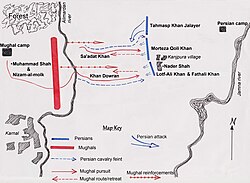
In 1738, Nader Shah conquered Kandahar, the last outpost of theHotaki dynastyand established Naderabad, Kandahar. His thoughts now turned to theMughal Empirebased in Delhi. This once powerful Muslim state to the east was falling apart as the nobles became increasingly disobedient and the HinduMaratha Empiremade inroads on its territory from the south-west. Its rulerMuhammad Shahwas powerless to reverse this disintegration. Nader asked for the Afghan rebels to be handed over, but the Mughal emperor refused.
Nader used the pretext of his Afghan enemies taking refuge in India to cross the border and invade the militarily weak but still extremely wealthy far eastern empire.[33]In a brilliant campaign against the governor of Peshawar, he took a small contingent of his forces on a daunting flank march through nearly impassable mountain passes, and took the enemy forces positioned at the mouth of theKhyber Passcompletely by surprise, decisively beating them despite being outnumbered two-to-one. This led to the capture ofGhazni,Kabul,Peshawar,SindhandLahore.
As Nader moved into the Mughal territories, he was accompanied by his loyalGeorgiansubject and future king ofeastern Georgia,Erekle II,who led a Georgian contingent as a military commander as part of Nader's force.[34]Following the defeat of Mughal forces priorly, he then advanced deeper into India, crossing theIndus Riverbefore the end of the year. The news of the Persian army's swift and decisive successes against the northern vassal states of the Mughal empire caused much consternation in Delhi, prompting the Mughal ruler, Muhammad Shah, to summon an overwhelming force of some 300,000 men and march this massive host north towards the Persian army.

Nader Shah crushed the Mughal army in less than three hours at the largeBattle of Karnalon 13 February 1739. After this decisive victory, Nader captured Mohammad Shah and entered with him into Delhi.[35]When a rumour broke out that Nader had been assassinated, some of the Indians attacked and killed Persian troops. Nader, furious, reacted by ordering his soldiers to plunder andsack the city.During the course of one day (March 22) 20,000 to 30,000 Indians were killed by the Persian troops, forcing Mohammad Shah to beg Nader for mercy.[36]
In response, Nader Shah agreed to withdraw, but Mohammad Shah paid the consequence in handing over the keys of his royal treasury, and losing even thePeacock Throneto the Persian emperor. The Peacock Throne thereafter served as a symbol of Persian imperial might. It is estimated that Nadir took away with him treasures worth as much as seven hundred million rupees. Among a trove of other fabulous jewels, Nader also gained theKoh-i-NoorandDarya-ye Noordiamonds (Koh-e-Noormeans "Mountain of Light" in Persian,Darya-ye Noormeans "Sea of Light" ).
The Persian troops left Delhi at the beginning of May 1739, but before they left, he ceded back to Muhammad Shah all territories to the east of the Indus that he had overrun.[37]Nader's soldiers also took with them thousands of elephants, horses and camels, loaded with the booty they had collected. On his return march, the Sikhs came out from the hills and ambushed Nader Shah's troops, taking some of the loot and captives with them.[38][39]However, the remaining plunder seized from India was so valuable that Nader stoppedtaxationin Iran for a period of three years following his return.[40]Nader attacked the empire to, perhaps, give his country some breathing space after previous turmoils. His successful campaign and replenishment of funds meant that he could continue his wars against Iran's archrival and neighbour, theOttoman Empire.[41]
North Caucasus, Central Asia, Arabia, and the second Ottoman war
[edit]
The Indian campaign was the zenith of Nader's career. After his return from India, Nader fell out with his eldest son Reza Qoli Mirza, who had ruled Persia during his father's absence. Reza had behaved highhandedly and somewhat cruelly but he had kept the peace in Persia. Having heard a rumour that Nader was dead, he had prepared to seize the throne by having the Safavid royal captives, Tahmasp and his nine-year-old son Abbas III, executed. On hearing the news, Reza's wife, who was Tahmasp's sister, committed suicide. Nader was not pleased with the young man's behaviour and humiliated him by removing him from the post of viceroy, but he took him on his expedition to conquer territory inTransoxiana.Nader became increasingly despotic as his health declined markedly. In 1740 he conquered Khanate ofKhiva.After the Persians had forced theUzbekkhanate ofBukharato submit, Nader wanted Reza to marry the khan's elder daughter because she was a descendant of his role model Genghis Khan, but Reza flatly refused and Nader married the girl himself. Nader also conqueredKhwarezmon this expedition into Central Asia.[42]
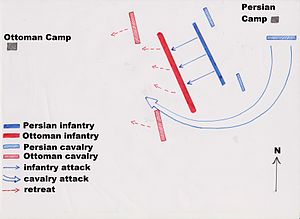
Nader now decided to punishDaghestanfor the death of his brother Ebrahim Qoli on a campaign a few years earlier. In 1741, while Nader was passing through the forest ofMazandaranon his way to fight the Daghestanis, an assassin took a shot at him but Nader was only lightly wounded. He began to suspect his son was behind the attempt and confined him toTehran.Nader's increasing ill health made his temper ever worse. Perhaps it was his illness that made Nader lose the initiative in his war against theLezgintribes of Daghestan. Frustratingly for him, they resorted to guerrilla warfare and the Persians could make little headway against them.[43]Though Nader managed to take most of Dagestan during his campaign, the effective guerrilla warfare as deployed by theLezgins,but also theAvars,LaksandDarginsmade the Iranian re-conquest of this particular North Caucasian region this time a short lived one; several years later, Naderwas forced to withdraw.During the same period, Nader accused his son of being behind the assassination attempt in Mazandaran. Reza angrily protested his innocence, but Nader had him blinded as punishment, although he immediately regretted it. Soon afterwards, Nader started executing the nobles who had witnessed his son's blinding. In his last years, Nader became increasingly paranoid, ordering the assassination of large numbers of suspected enemies.
With the wealth he gained, Nader started to build a Persian navy. With lumber fromMazandaranandGilan,he built ships inBushehrand order to build new artillery inAmol.He also purchased thirty ships in India.[25]He recaptured the island ofBahrainfrom the Arabs. In 1743, he conqueredOmanand its main capitalMuscat.In 1743, Nader started another war against the Ottoman Empire. Despite having a huge army at his disposal, in this campaign Nader showed little of his former military brilliance. It ended in 1746 with the signing of a peace treaty, in which the Ottomans agreed to let Nader occupyNajaf.[44]
Military
[edit]The military forces of the Afsharid dynasty of Persia had their origins in the relatively obscure yet bloody inter-factional violence in Khorasan during the collapse of the Safavid state. The small band of warriors under local warlordNader Qoliof the Turkomen Afshar tribe in north-east Iran were no more than a few hundred men. Yet at the height of Nader's power as the king of kings, Shahanshah, he commanded an army of 375,000 fighting men which constituted the single most powerful military force of its time,[45][46]led by one of the most talented and successful military leaders of history.[47]
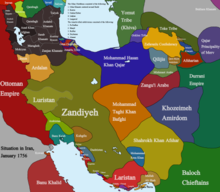
After the assassination of Nader Shah at the hands of a faction of his officers in 1747, Nader's powerful army fractured as the Afsharid state collapsed and the country plunged into decades of civil war. Although there were numerous Afsharid pretenders to the throne, (amongst many other), who attempted to regain control of the entire country, Persia remained a fractured political entity in turmoil until the campaigns ofAgha Mohammad Khan Qajartoward the very end of the eighteenth century reunified the nation.
Civil war and downfall of the Afsharids
[edit]
After Nader's death in 1747, his nephew Ali Qoli (who may have been involved in the assassination plot) seized the throne and proclaimed himselfAdel Shah( "The Just King" ). He ordered the execution of all Nader's sons and grandsons, with the exception of the 13-year-oldShahrokh,the son of Reza Qoli.[49]Meanwhile, Nadir's former treasurer,Ahmad Shah Abdali,had declared his independence by founding theDurrani Empire.In the process, the eastern territories were lost and in the following decades became part ofAfghanistan,the successor-state to the Durrani Empire. The northern territories, Iran's most integral regions, had a different fate.Erekle IIandTeimuraz II,who, in 1744, had been made the kings ofKakhetiandKartlirespectively by Nader himself for their loyal service,[50]capitalized on the eruption of instability and declaredde factoindependence. Erekle II assumed control over Kartli after Teimuraz II's death, thus unifying the two as theKingdom of Kartli-Kakheti,becoming the first Georgian ruler in three centuries to preside over a politically unified eastern Georgia,[51]and due to the frantic turn of events in mainland Iran he would be able to remainde factoautonomous through theZandperiod.[52]Under the successiveQajar dynasty,Iran managed torestore Iranian suzeraintyover the Georgian regions, until they would be irrevocably lost in thecourse of the 19th century,to neighbouringImperial Russia.[53]Many of the rest of the territories in the Caucasus, comprising modern-day [Azerbaijan, Armenia, andDagestan,broke away into variouskhanates.Until the advent of theZandsand Qajars, its rulers had various forms of autonomy, but stayed vassals and subjects to the Iranian king.[54]Under the early Qajars, these territories inTranscaucasiaand Dagestan would all be fully reincorporated into Iran, but eventually permanently lost as well (alongside Georgia), in the course of the 19th century to Imperial Russia through the twoRusso-Persian Warsof the 19th century.[53]
Adil made the mistake of sending his brotherEbrahimto secure the capital Isfahan. Ebrahim decided to set himself up as a rival, defeated Adil in battle, blinded him and took the throne. Adil had reigned for less than a year. Meanwhile, a group of army officers freed Shahrokh from prison in Mashhad and proclaimed him shah in October 1748. Ebrahim was defeated and died in captivity in 1750 and Adil was also put to death at the request of Nader Shah's widow. Shahrokh was briefly deposed in favour of another puppet ruler Soleyman II but, although blinded, Shahrokh was restored to the throne by his supporters. He reigned in Mashhad and from the 1750s his territory was mostly confined to the city and its environs. He also faced the Durrani invasions into Khorasan, eventually becoming subjugated to them inAhmad Shah'ssecond campaign.[48]In 1796Mohammad Khan Qajar,the founder of theQajar dynasty,seized Mashhad and tortured Shahrokh to force him to reveal the whereabouts of Nader Shah's treasures. Shahrokh died of his injuries soon after and with him the Afsharid dynasty came to an end.[55][56]One of Shahrokh's sons,Nader Mirza,revolted in 1797 upon the death of Agha Mohammad Khan Qajar but the revolt was crushed and he was executed in April 1803. Shahrokh's descendants continue into the 21st century under the Afshar Naderi surname.
Religious policy
[edit]The Safavids had introducedShi'a Islamas the state religion of Iran. Nader was brought up as a Shi'a[57]but later sympathised and desired unity with theSunni[58]faith as he gained power and began to push into the Ottoman Empire. He believed that Safavid Shi'ism had intensified the conflict with the Sunni Ottoman Empire. His army was a mix of Shi'a and Sunni (with a notable minority of Christians) and included his ownQizilbashas well as Uzbeks, Afghans, ChristianGeorgiansandArmenians,[59][60]and others. He wanted Persia to adopt a form of Shi'a Islam that would be more acceptable to Sunnis and suggested that Persia adopt a form of Shi'ism he called "Ja'fari", in honour of the sixth Shi'a ImamJa'far al-Sadiq.He banned certain Shi'a practices which were particularly offensive to Sunnis, such as the cursing of the first three caliphs. Personally, Nader is said to have been indifferent toward religion and the FrenchJesuitwho served as his personal physician reported that it was difficult to know which religion he followed and that many who knew him best said that he had none.[55]Nader hoped that "Ja'farism" would be accepted as a fifth school (mazhab) of Sunni Islam and that the Ottomans would allow its adherents to go on thehajj,or pilgrimage, toMecca,which was within their territory. In the subsequent peace negotiations, the Ottomans refused to acknowledge Ja'farism as a fifthmazhabbut they did allow Persian pilgrims to go on thehajj.Nader was interested in gaining rights for Persians to go on thehajjin part because of revenues from the pilgrimage trade.[25]Nader's other primary aim in his religious reforms was to weaken the Safavids further since radical Shi'a Islam had always been a major element in support for the dynasty. He had the chiefmullahof Persia strangled after he was heard expressing support for the Safavids. Among his reforms was the introduction of what came to be known as thekolah-e Naderi.This was a hat with four peaks which symbolised the first fourcaliphs.
Flag
[edit]Nader Shah consciously avoided the using the colour green, as green was associated withShia Islamand theSafavid dynasty.[61]
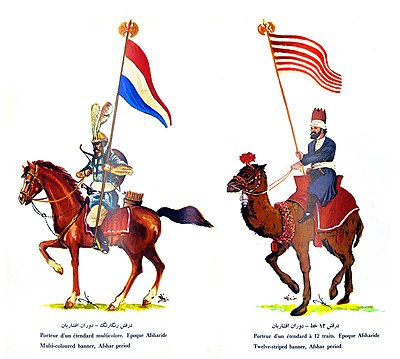
The two imperial standards were placed on the right of the square already mentioned: one of them was in stripes of red, blue, and white, and the other of red, blue, white, and yellow, without any other ornament: though the old standards required 12 men to move them, the SHAH lengthened their staffs, and made them yet heavier; he also put new colours of silk upon them, the one red and yellow striped, the other yellow edged with red: they were made of such an enormous size, to prevent their being carried off by the enemy, except by an entire defeat. The regimental colours were a narrow slip of silk, sloped to a point, some were red, some white, and some striped.[62][63]
Navy Admiral flag being a white ground with a red Persian Sword in the middle.[64] Although based on the writings ofJonas Hanway,we can see that the flags of the army regiments of King Nader were three-eared, but we cannot come to a conclusion about whether the royal flags of that time were three-eared or four-eared.
Gallery
[edit]Afsharians parade inPersepolis
Notes
[edit]References
[edit]- ^Katouzian, Homa (2003).Iranian History and Politics.Routledge. p. 128.ISBN0-415-29754-0.
Indeed, since the formation of the Ghaznavids state in the tenth century until the fall of Qajars at the beginning of the twentieth century, most parts of the Iranian cultural regions were ruled by Turkic-speaking dynasties most of the time. At the same time, the official language was Persian, the court literature was in Persian, and most of the chancellors, ministers, and mandarins were Persian speakers of the highest learning and ability.
- ^"HISTORIOGRAPHY vii. AFSHARID AND ZAND PERIODS – Encyclopaedia Iranica".Archivedfrom the original on 2018-12-25.Retrieved2022-10-22.
Afsharid and Zand court histories largely followed Safavid models in their structure and language, but departed from long-established historiographical conventions in small but meaningful ways.
- ^",V. Bulletin of the School of Oriental Studies, University of London, vol. 9, no. 4, 1939, pp. 1119–23.JSTOR
- ^"THE TURKISH INSCRIPTION OF KALĀT-İ NĀDIRĪ", Tourkhan Gandjeï,Wiener Zeitschrift für die Kunde des Morgenlandes,Vol. 69 (1977), pp. 45-53 (10 pages).JSTOR
- ^Axworthy, Michael (2008).A History of Iran: Empire of the Mind.New York: Basic Books. pp. 160, 167.ISBN978-0-465-00888-9.OCLC182779666.
- ^Aliasghar Shamim, Iran during the Qajar Reign, Tehran: Scientific Publications, 1992, p. 287
- ^Amanat 1997,p. 13.
- ^Amanat 2017,pp. 145–156.
- ^Pickett, James (2016). "Nadir Shah's Peculiar Central Asian Legacy: Empire, Conversion Narratives, and the Rise of New Scholarly Dynasties".International Journal of Middle East Studies.48(3): 491–510.doi:10.1017/S0020743816000453.ISSN0020-7438.JSTOR43998158.S2CID159600918.
- ^Tucker, Ernest (2012)."Afshārids".In Fleet, Kate; Krämer, Gudrun; Matringe, Denis; Nawas, John; Rowson, Everett (eds.).Encyclopaedia of Islam, THREE.Brill Online.ISSN1873-9830.Archivedfrom the original on 2022-08-09.Retrieved2022-05-23.
The Afshārids (r. 1149–1210/1736–96) were a Persian dynasty founded by Nādir Shāh Afshār, replacing the Ṣafavid dynasty.
- ^Lockhart, L., "Nadir Shah: A Critical Study Based Mainly upon Contemporary Sources", London: Luzac & Co., 1938, 21:"Nadir Shah was froma Turkmen tribeand probably raised as a Shiʿa, though his views on religion were complex and often pragmatic "
- ^Mikaberidze, Alexander (2011).Conflict and Conquest in the Islamic World: A Historical Encyclopedia, Vol.1.ABC Clio, LLC. p. 408.ISBN978-1-59884-336-1."This event marked the twilight of the Safavid power but also served as a launching pad for anAfshar Turkomancommander named Nadir Shah. "
- ^Axworthy 2006,p.back cover."Nader Shah, ruler of Persia from 1736 to 1747, embodied ruthless ambition, energy, military brilliance, cynicism and cruelty"
- ^Axworthy 2006,pp. 17–19. "His father was of lowly but respectable status, a herdsman of theAfshar tribe... The Qereqlu Afshars to whom Nader's father belonged were a semi-nomadic Turcoman tribe settled in Khorasan] in north-eastern Iran... The tribes of Khorasan were for the most part ethnically distinct from the Persian-speaking population, speaking Turkic or Kurdish languages. Nader's mother tongue was a dialect of the language group spoken by the Turkic tribes of Iran and Central Asia, and he would have quickly learned Persian, the language of high culture and the cities as he grew older. But the Turkic language was always his preferred everyday speech, unless he was dealing with someone who knew only Persian. "
- ^Cambridge History of IranVolume 7, pp. 2–4
- ^Encyclopædia IranicaArchived2020-05-26 at theWayback Machine:"Born in November 1688 into a humble pastoral family, then at its winter camp in Darra Gaz in the mountains north of Mashad, Nāder belonged to a group of the Qirqlu branch of the Afšār Turkmen."
- ^Encyclopædia Iranica[permanent dead link]
- ^Martin, Samuel Elmo (1997).Uralic And Altaic Series.Routledge. p. 47.ISBN0-7007-0380-2.Archivedfrom the original on 2020-06-02.Retrieved2022-05-23.
- ^Michael AxworthyIran: Empire of the Mind(Penguin, 2008) pp.153–156
- ^Dowling, Timothy C. (2 December 2014).Russia at War: From the Mongol Conquest to Afghanistan, Chechnya, and Beyond...Abc-Clio.ISBN978-1-59884-948-6.Archivedfrom the original on 10 April 2023.Retrieved25 December2014.
- ^Tucker, Ernest (2006)."Nāder Shah".Encyclopædia Iranica Online.Archivedfrom the original on 25 December 2018.Retrieved5 January2014.
- ^"Dataci.Net İstanbul Antlaşması (1736)".
- ^Axworthy 2006,pp. 57–74
- ^Axworthy 2006,pp. 75–116
- ^abcEncyclopædia Iranica
- ^Elton L. Daniel, "The History of Iran" (Greenwood Press 2000) p. 94
- ^Lawrence LockhartNadir Shah(London, 1938)
- ^abcdeFisher et al. 1991,pp. 34.
- ^Fisher et al. 1991,pp. 36.
- ^Fisher et al. 1991,pp. 35.
- ^Axworthy 2006,pp. 137–174
- ^Fisher et al. 1991,pp. 34–36.
- ^Raghunath Rai. "History". p. 19 FK PublicationsISBN81-87139-69-2
- ^David Marshall Lang.Russia and the Armenians of Transcaucasia, 1797-1889: a documentary recordArchived2023-04-07 at theWayback MachineColumbia University Press, 1957 (digitalised March 2009, originally from theUniversity of Michigan) p 142
- ^"An Outline of the History of Persia During the Last Two Centuries (A.D. 1722-1922)".Edward G. Browne.London: Packard Humanities Institute. p. 33.Archivedfrom the original on 2016-03-04.Retrieved2010-09-24.
- ^Axworthy 2006,pp. 7–8
- ^Axworthy 2006,pp. 212, 216
- ^"Rise, Growth and Fall of the Bhangi Misl".CiteSeerX10.1.1.693.6648.
- ^Singh, Khushwant (2004).A History of the Sikhs: 1469-1838.Oxford University Press.ISBN978-0-19-567308-1.Archivedfrom the original on 2023-04-10.Retrieved2022-05-23.
- ^Axworthy 2006,pp. 1–16, 175–210
- ^Axworthy 2006,p.[page needed]
- ^svat soucek, a history of inner Asia page 195: in 1740 Nadir Shah, the new ruler of Iran, crossed the Amu Darya and, accepting the submission of Muhammad Hakim Bi which was then formalized by the acquiescence of Abulfayz Khan himself, proceeded to attack Khiva. When rebellions broke out in 1743 upon the death of Muhammad Hakim, the shah dispatched the ataliq's son Muhammad Rahim Bi, who had accompanied him to Iran, to quell them. Mohammad hakim bi was ruler of the khanate of bukhara at that time. Page link:"Page 195 a History of Inner Asia Librarum.org".Archived fromthe originalon 2015-06-10.Retrieved2015-07-16.
- ^Spencer C. Tucker."A Global Chronology of Conflict: From the Ancient World to the Modern Middle East: From the Ancient World to the Modern Middle East"Archived2023-04-07 at theWayback Machinep 739
- ^Axworthy 2006,pp. 175–274
- ^Axworthy, Michael (2007). "The Army of Nader Shah".Iranian Studies.40(5). Informa UK: 635–646.doi:10.1080/00210860701667720.S2CID159949082.
- ^Axworthy, Michael(2009).The Sword of Persia: Nader Shah, from tribal warrior to conquering tyrant,.I. B. Tauris
- ^Axworthy, Michael, "Iran: Empire of the Mind", Penguin Books, 2007. p158
- ^abMalcolm, Sir John (1829).The History of Persia: From the Most Early Period to the Present Time.Murray.Archivedfrom the original on 2023-04-10.Retrieved2022-05-23.
- ^Cambridge Historyp.59
- ^Ronald Grigor Suny."The Making of the Georgian Nation"Archived2023-04-10 at theWayback MachineIndiana University Press,1994.ISBN978-0-253-20915-3p 55
- ^Yar-Shater, Ehsan.Encyclopædia Iranica, Vol.8,parts 4-6Archived2023-04-07 at theWayback MachineRoutledge & Kegan Paul (original from theUniversity of Michigan) p 541
- ^Fisher et al. 1991,p. 328.
- ^abTimothy C. DowlingRussia at War: From the Mongol Conquest to Afghanistan, Chechnya, and BeyondArchived2023-04-10 at theWayback Machinep 728-729 ABC-CLIO, 2 dec. 2014ISBN1-59884-948-4
- ^Encyclopedia of Soviet law By Ferdinand Joseph Maria Feldbrugge, Gerard Pieter van den Berg, William B. Simons, Page 457
- ^abAxworthy p.168
- ^Cambridge Historypp.60–62
- ^Axworthy p.34
- ^Mattair, Thomas R. (2008).Global security watch--Iran: a reference handbook.ABC-CLIO. p. 3.ISBN978-0-275-99483-9.Archivedfrom the original on 2023-04-10.Retrieved2010-09-24.
- ^"The Army of Nader Shah"(PDF).Archived fromthe original(PDF)on 3 March 2016.Retrieved17 December2014.
- ^Steven R. Ward.Immortal, Updated Edition: A Military History of Iran and Its Armed ForcesGeorgetown University Press, 8 jan. 2014 p 52
- ^Shapur Shahbazi|1999|Encyclopædia Iranica
- ^Hanway, Jonas (1753). "XXXVII". An Historical Account of the British Trade over the Caspian Sea: With a Journal of Travels through Russia into Persią. 248-249. London: Mr. Dodsley. Retrieved 15 January 2020.
- ^"An Historical Account of the British Trade over the Caspian Sea Vol.1,2".1753.
- ^Nādir Shāh's Campaigns in 'Omān, 1737–1744 By Laurence Lockhart, Bulletin of the School of Oriental Studies, University of London,Vol. 8, No. 1 (1935), pp. 157–171
Sources
[edit]- Amanat, Abbas (1997).Pivot of the Universe: Nasir Al-Din Shah Qajar and the Iranian Monarchy, 1831-1896.I.B.Tauris.ISBN978-1-84511-828-0.
- Amanat, Abbas(2017).Iran: A Modern History.Yale University Press. pp. 1–992.ISBN978-0-300-11254-2.
- Axworthy, Michael(2006).The Sword of Persia: Nader Shah, from Tribal Warrior to Conquering Tyrant.I.B.Tauris.ISBN978-1-85043-706-2.
- Fisher, William Bayne; Avery, P.; Hambly, G. R. G; Melville, C. (1991).The Cambridge History of Iran.Vol. 7. Cambridge:Cambridge University Press.ISBN0-521-20095-4.
- Rota, Giorgio (2020). "In a League of Its Own? Nāder Šāh and His Empire". In Rollinger, Robert; Degen, Julian; Gehler, Michael (eds.).Short-term Empires in World History.Springer. pp. 215–226.
- Tucker, Ernest (2012)."Afshārids".In Fleet, Kate;Krämer, Gudrun;Matringe, Denis; Nawas, John;Rowson, Everett(eds.).Encyclopaedia of Islam(3rd ed.). Brill Online.ISSN1873-9830.
- Afsharid dynasty
- Afsharid Iran
- Empires and kingdoms of Iran
- 1730s in Iran
- 1740s in Iran
- 1750s in Iran
- 1760s in Iran
- 1770s in Iran
- 1780s in Iran
- 1790s in Iran
- 1800s in Iran
- States and territories established in 1736
- States and territories disestablished in 1796
- 1736 establishments in Asia
- 1796 disestablishments in Asia
- States and territories established by the Afshar tribe
- Historical transcontinental empires
- Former countries





